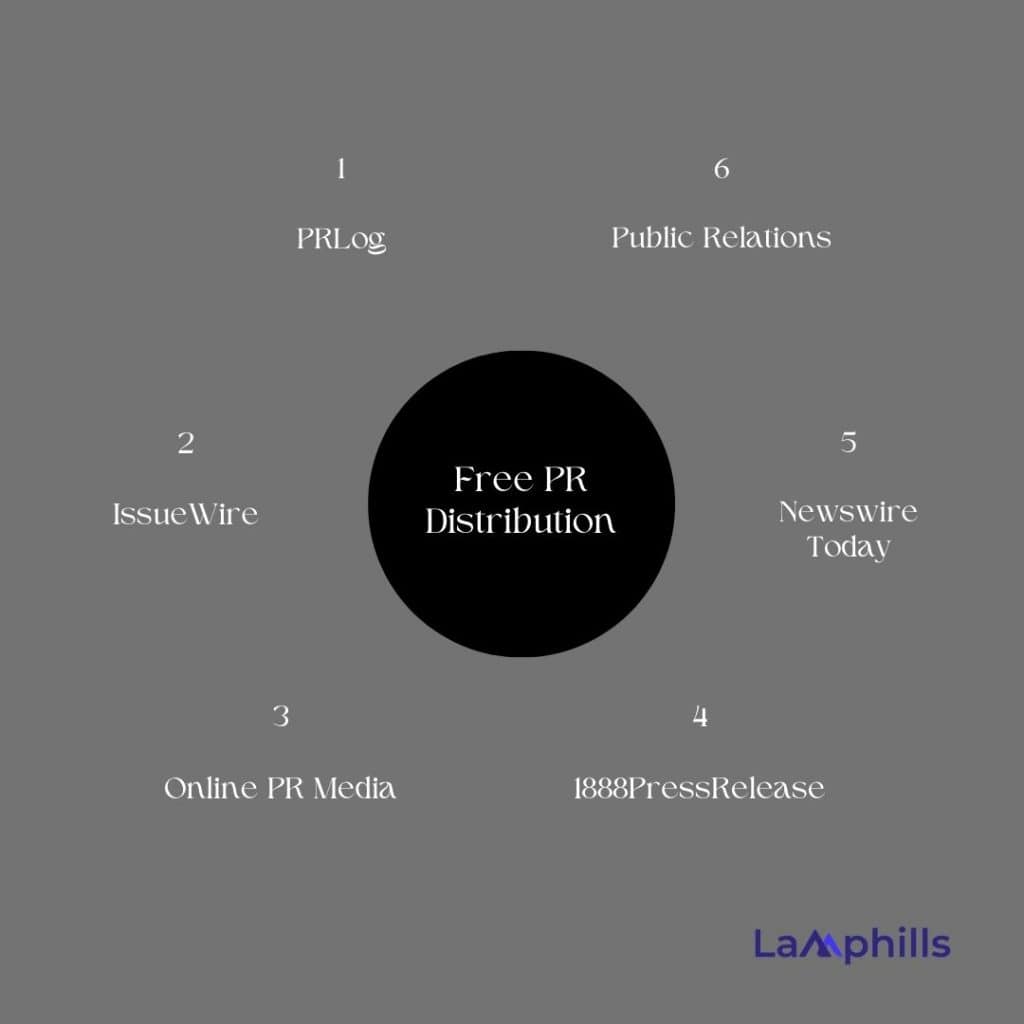After navigating the fast-paced world of public relations (PR) for some years, I’ve realized that the success of every campaign depends on efficient PR distribution. While a poorly implemented plan can cause your efforts to fail, a well-executed strategy can connect with your target audience and enhance your message. In this article, I’ll share my experience creating a free PR distribution software strategy that engages the target audience and produces outcomes.
Key Points
- PR distribution is distributing news or press releases to reporters, media organizations, and the general public to increase visibility.
- PR distribution develops and distributes messages, manages media, and tracks outcomes to build brand reputation.
- A brand can improve its reputation with the target audience and raise its exposure using paid and earned PR.
- This unpaid media attention was obtained by establishing strong connections with journalists and conducting extensive media outreach.
- Paying for media placements or using paid PR distribution firms ensures visibility.
Overview
Writing about a noteworthy occurrence is crucial, but it won’t be enough to draw attention. Your press release must be sent in a specific manner if you want the proper people to view it. Press release distribution can be helpful in this situation.
Reaching the appropriate audience with a press release is known as PR distribution. Press release distributors connect businesses with reporters and media outlets by distributing a news release through networks or news wires. However, to maximize visibility and coverage for the news or announcement it contains, a top-notch press release distribution service specializes in distributing press releases to a broad range of targeted media outlets, journalists, and industry-specific audiences.
Press release distribution is not only a useful marketing strategy for famous people or large corporations. In actuality, sending a release at the appropriate moment could be advantageous for the majority of business owners. Also, using a press release properly can help you promote new goods and services, boost search engine optimization, and perhaps attract some local attention. It all comes down to having the proper PR distribution strategy.
Also Read: Best Free Press Release Distribution Sites for 2024
My Experience: Gaining Knowledge of PR Distribution
I managed the launch of a product for a small software business early in my career. There was a noticeable buzz in the office, but as the launch date drew nearer, I became aware that we still lacked a sound PR distribution strategy. I soon discovered that PR distribution included distributing press releases and other media content to the public, influencers, and journalists.
However, I started the process by looking into the several ways we might distribute our press release. I learned that PR distribution services come in both free and paid varieties. Free PR distribution first appealed to me since I believed it would help us stick to our tight budget.
Techniques for PR Distribution
Depending on the kind of campaign and target demographic, these techniques have assisted me in efficiently distributing press releases. The following are a few essential PR distribution strategies:
#1. Press Release Distribution Services
I frequently publish news releases using platforms like PR Newswire, Business Wire, or PRLog. They make certain my news is seen by several journalists and media outlets. While free services work well for smaller campaigns, paid services typically offer a greater reach.
#2. Company Website
I also utilize the corporate website to post press releases. In addition to keeping users informed, it enhances SEO since search engines index the release.
#3. Email Campaigns
Sending press releases to my email subscriber list directly has worked for me. However, this guarantees that the most interested viewers receive the news first.
#4. Engaging Journalists Directly
There are instances when I send press releases straight to reporters who have written on related subjects, cutting out the intermediary. However, this one-on-one strategy boosts coverage odds and fosters relationships.
#5. Social Media
I consistently distribute press releases on social media sites like Twitter and LinkedIn. It’s a fast way to spread the word and interact with more people. The posts can occasionally be picked up by journalists or influencers via social media.
#6. Media Kits
I have produced press releases, business information, and excellent images as part of media kits. However, these kits provide journalists and media outlets with all the resources they need to produce a compelling narrative.
Free PR Distribution
I first depended largely on free PR distribution services because I didn’t have a large budget when I started handling PR. Without spending a fortune, they can be an excellent way to distribute your press release. I found that using both free and paid solutions yields better outcomes, even if free services helped get me started. Paid services allow you to reach major media outlets, but free services are excellent for SEO and specialized markets. Once you realize the benefit, think about investing in premium choices to expand your reach. Start with free distribution and see where it takes you. The following are a few free PR distribution platforms that I found to be effective:
#1. PRLog
PRLog is a good free PR distribution platform that is simple to use and lets you include photographs, videos, and links with your press release. It works effectively for startups or small businesses and has a respectable reach.
#2. IssueWire
IssueWire’s reach impressed me when I used it for free distribution a couple of times. Free features offered by the platform include distribution to several news websites and backlinks, which aid in SEO.
#3. Online PR Media
Although they have paid options, their free alternative is also very useful. They enable multimedia press releases and are also useful for including pictures to add interest to the release. Because the releases typically score highly in search engines, it’s excellent for SEO.
#4. 1888PressRelease
You can distribute PRs for free on this site, which also provides some tracking capabilities. It is easy for novices to use because of its simple submission procedure.
#5. Newswire Today
It has subscription plans, but for small businesses who want to reach a larger audience with their news, its free version is excellent. I utilized it to get free access to a few specialized markets.
#6. Public Relations
You can distribute press releases and improve your website’s SEO using PR.com, another free option. In addition to backlinking, I’ve utilized it to attract some attention from specialist industries.

PR Distribution Software
My PR efforts now run much more smoothly thanks to these PR distribution tools, and I change between them based on the audience and budget. For me, employing PR distribution tools changed everything when I started doing PR campaigns. From creating and spreading press releases to monitoring performance and media engagement, these tools also simplify the entire process. I’ve found the following leading PR distribution software systems to be useful:
#1. Cision
When I need to target particular journalists, I use Cision. I can locate the appropriate persons thanks to its vast media database. Additionally, it examines the effect of the press release. Using Cision to connect with the ideal journalist, I once secured coverage in a leading tech publication.
#2. Prowly
Prowly is invaluable when it comes to smaller expenses. However, it’s inexpensive and simple to use, and I’ve used it to secure coverage in specialized magazines without breaking the bank.
#3. Prezly
I use Prezly whenever I need an eye-catching press release. Its multimedia capabilities enabled me to attract lifestyle blogs to a campaign that required a greater emphasis on images.
#4. PR Newswire
PR Newswire is what I use for large-scale initiatives. Although it’s a little expensive, press releases are seen by people all around the world. However, PR Newswire was able to help me access global markets for a product launch.
#5. Muck Rack
I always use this to create media lists. I’ve also had a lot of success getting in touch with reporters who have written on my sector lately. My IT product launch attracted the eye of multiple media when I used Muck Rack.
The Best Ways to Build a PR Distribution Strategy
Over the years, I have been able to improve my PR distribution plan and constantly get greater results thanks to these ideas. However, using these resources, I realized I needed to create a PR distribution strategy that would reach as many people as possible. The following are a few best practices for creating a PR distribution plan below:
#1. Establish Your Target Market
It’s important to know who you want to reach before you distribute any content. For our project, I began by developing thorough customer profiles. Knowing their demographics, hobbies, and media consumption patterns allowed me to modify my messaging.
#2. Build Engaging Content
A well-written press release is the cornerstone of every PR distribution plan. I’ve learned from my past attempts that telling a tale is essential. However, I created stories that highlighted the advantages of the product and gave prospective customers instances of how it might be used to address problems in the real world.
#3. Employ Both Paid and Free PR Distribution Methods
I discovered that employing commercial services (like PR Newswire or Business Wire) significantly expands reach, even though I initially used free PR distribution platforms like PRLog. You get more coverage when you combine the two.
#4. Establish Connections with Journalists
I came to understand the value of building relationships with influencers and journalists as I made my way through the PR world. I deliberately tried to get in touch with them directly, sharing insider information and asking them about events. It was simpler to secure coverage for my efforts after establishing these relationships.
#5. The Timing of Press Releases
Press release scheduling is crucial. I’ve discovered that giving them out in the middle of the morning on Tuesdays or Wednesdays increases participation. Because they are either catching up or finishing up for the week, the journalist stays away on Mondays and Fridays.
#6. Use Social Media
I post press releases on sites like LinkedIn and Twitter when they are sent out. It helps reach a wider audience and boost visibility. It’s also a plus if influencers spread the word. Incorporate Multimedia: Since journalists are visual learners, I always make an effort to include a video or excellent photos with the release. The likelihood of the press release being picked up increases.
#7. Make Use of Appropriate Distribution Channels
Selecting the appropriate distribution channels is crucial to successfully reaching your target audience. I tested with different platforms while taking pricing, reach, and industry focus into account. Every time we introduced a new product, I assessed which distribution channels would work best.
#8. Track and Examine Outcomes
Following the execution of our distribution strategy, I started keeping a careful eye on the outcomes. I examined media mentions, click-through rates, and open rates using the statistics from our PR distribution platform. This data offered insightful information about what was effective and what needed modification. As an example, I discovered that press releases delivered on Tuesdays outperformed those sent on Fridays.
#9. Evaluate Your Performance
I monitor website traffic, social media activity, and media coverage following each press release. This aids in my comprehension of what is effective and where I may make improvements going forward.
#10. Change and Develop
Adaptability is essential in the ever-changing PR landscape. As my experience grew, I developed the practice of keeping up with changing media tastes and industry trends. To increase engagement rates, I started adding pictures and videos to the press releases after noticing an increasing desire for multimedia material.
These initiatives paid off with a successful product launch that exceeded our sales targets. Our trust in the business was established, and brand awareness was raised by the press coverage we obtained from different venues. I often take stock of that journey and my progress in becoming an expert in PR distribution. One of my happiest moments was when a national outlet emailed me to express interest in doing an article about our product. Our PR activities were a result of careful preparation and a lot of hard work.
How to Assess the Effectiveness of Your PR Distribution
Monitoring these crucial factors will provide you a full understanding of how well your PR distribution is working. The following is how to determine how successful PR distribution is:
#1. Media Coverage
Monitoring the number and grade of media sources that receive your press release is important. Placements in magazines that appeal to your target demographic should be your priority.
#2. Website Traffic
Analyze traffic growth after the release with Google Analytics. Keep an eye on news providers’ referral traffic and monitor interaction on important pages.
#3. Audience Feedback
Examine straight answers to questions, remarks, and comments. Positive comments and interest in the news release show how relevant it is.
#4. Lead Generation
Monitor conversions to determine whether the PR produces observable commercial outcomes, like sign-ups, product queries, or purchases.
#5. SEO Impact
Monitor increases in search engine rankings and backlinks resulting from media coverage. Long-term visitors and SEO also benefit from public relations (PR) distribution.
#6. Social Media Engagement
Track retweets, comments, shares, and likes on social media sites like Twitter and LinkedIn. Strong social interaction indicates that your message is getting through.
#7. Earned Media Value (EMV)
In those same channels, compare the expected worth of publicity with the cost of advertising.
PR Distribution Advantages
Some benefits of PR distribution include the following:
#1. A Greater Awareness of the Brand
Especially during significant announcements, press releases help me expose my business to a larger audience.
#2. Credibility
Reputable media sources’ coverage creates confidence among investors and consumers.
#3. Using Social Media
A strong PR release frequently generates social media shares and discussion.
#4. Enhancement of SEO
Press releases that contain backlinks raise the search engine rankings of the website and increase natural visitors.
#5. Choosing the Correct Audience to Target
I can reach particular audiences by releasing to media outlets that are relevant to the sector.
Limitations of PR Distribution
These disadvantages should be taken into account while organizing a campaign, even when PR distribution has advantages. The following are the PR distribution disadvantages:
#1. Cost
Numerous trustworthy distribution providers can be costly, even when there are cheap alternatives. Especially for smaller projects, I have had to balance the possible reach and advantages against the cost.
#2. Varying Outcomes
The intended level of media attention or interaction won’t be produced by every press release. I have experienced dissatisfaction and wasted work as a result of campaigns that didn’t function as planned.
#3. Overcrowding
Being unique can be difficult because so many companies use PR distribution. Well-written publications can occasionally get buried in the shuffle.
#4. The Reliance on Journalists
Success is not assured when I rely on journalists to report on my release. I might not get the audience I wanted for my news if they are busy or uninterested.
#5. Limited Authority
After a press release is sent out, I frequently have little control over how the media represents or covers it. Important details may be missed or misunderstood as a result.
Also Read: BEST FREE PRESS RELEASE DISTRIBUTION WEBSITES IN 2024
What is the PR distribution?
Distributing a press release to journalists, the media, and the general population is known as PR distribution. Guaranteeing that the information reaches the intended audience entails distributing press releases to media outlets, utilizing online channels, and utilizing distribution platforms. Increasing visibility, generating media coverage, and increasing brand recognition are the goals.
How does PR work?
The strategic communication method known as public relations (PR) aids in the development of connections between businesses and their target audience. Public relations (PR) operates as follows:
- Creating a Message: Craft an engaging statement, news, or story about the company.
- Distribution: Use a variety of platforms, such as events, social media, media outreach, and press releases, to spread the word.
- Media Relations: To improve the likelihood that the message will be shared, cultivate a strong connection with influencers and journalists.
- Monitoring: To gauge success and modify future tactics, keep an eye on public responses, media coverage, and the overall effect of the PR campaigns.
Is PR paid or earned?
PR can be earned or purchased. A brand’s exposure and reputation can be enhanced by both earned and purchased public relations (PR). The following are clarified:
- Unpaid media coverage, or earned PR, is when reporters or influencers pick up a company’s news or story and distribute it for free. Usually, relationship-building and media outreach lead to this.
- To ensure visibility, paid PR entails using paid distribution services or purchasing media placement. Sponsored content, paid press releases, and media outlet ads are a few examples.
Conclusion
A careful strategy and ongoing learning are necessary for effective PR distribution, which is a combination of art and science. I learned the significance of establishing connections, creating engaging content, and tracking results via my transition from using free distribution providers to using full-featured PR distribution tools. You, too, can develop a PR distribution strategy that engages the appropriate audience and generates significant interaction by putting these best practices into effect. Remember that determination and adaptability are the cornerstones of PR success, regardless of whether you’re just getting started or trying to improve your current approach.
Related Articles
- Top PR Platforms for 2024: How to Elevate Your Public Relations Strategy
- Understanding Market Coverage: Definition, Types, and Importance for Your PR Strategy
- What is Audio News Release? A Comprehensive Guide to Creating an Effective News Release
- How to Develop a Creative Strategy Like a Pro: Tips, Examples, and Templates
- Mastering the Art of a Comprehensive Competitive Analysis Report






